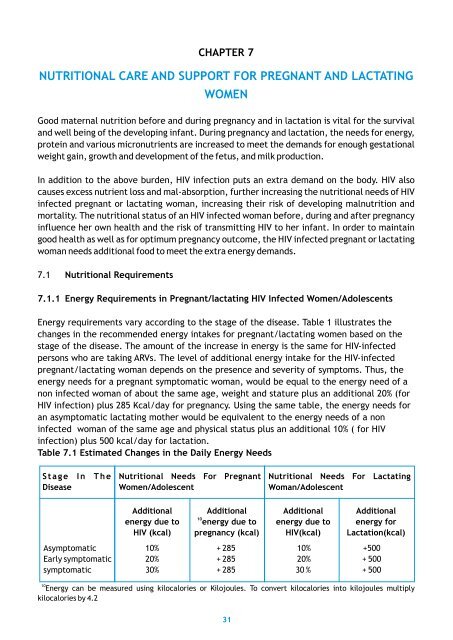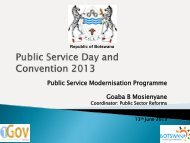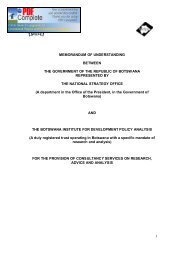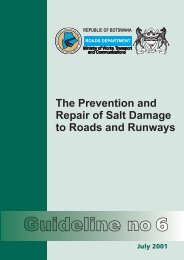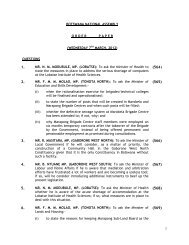National Nutrition and HIV/AIDS Guidelines for Service Providers of ...
National Nutrition and HIV/AIDS Guidelines for Service Providers of ...
National Nutrition and HIV/AIDS Guidelines for Service Providers of ...
You also want an ePaper? Increase the reach of your titles
YUMPU automatically turns print PDFs into web optimized ePapers that Google loves.
CHAPTER 7<br />
NUTRITIONAL CARE AND SUPPORT FOR PREGNANT AND LACTATING<br />
Good maternal nutrition be<strong>for</strong>e <strong>and</strong> during pregnancy <strong>and</strong> in lactation is vital <strong>for</strong> the survival<br />
<strong>and</strong> well being <strong>of</strong> the developing infant. During pregnancy <strong>and</strong> lactation, the needs <strong>for</strong> energy,<br />
protein <strong>and</strong> various micronutrients are increased to meet the dem<strong>and</strong>s <strong>for</strong> enough gestational<br />
weight gain, growth <strong>and</strong> development <strong>of</strong> the fetus, <strong>and</strong> milk production.<br />
In addition to the above burden, <strong>HIV</strong> infection puts an extra dem<strong>and</strong> on the body. <strong>HIV</strong> also<br />
causes excess nutrient loss <strong>and</strong> mal-absorption, further increasing the nutritional needs <strong>of</strong> <strong>HIV</strong><br />
infected pregnant or lactating woman, increasing their risk <strong>of</strong> developing malnutrition <strong>and</strong><br />
mortality. The nutritional status <strong>of</strong> an <strong>HIV</strong> infected woman be<strong>for</strong>e, during <strong>and</strong> after pregnancy<br />
influence her own health <strong>and</strong> the risk <strong>of</strong> transmitting <strong>HIV</strong> to her infant. In order to maintain<br />
good health as well as <strong>for</strong> optimum pregnancy outcome, the <strong>HIV</strong> infected pregnant or lactating<br />
woman needs additional food to meet the extra energy dem<strong>and</strong>s.<br />
7.1 <strong>Nutrition</strong>al Requirements<br />
WOMEN<br />
7.1.1 Energy Requirements in Pregnant/lactating <strong>HIV</strong> Infected Women/Adolescents<br />
Energy requirements vary according to the stage <strong>of</strong> the disease. Table 1 illustrates the<br />
changes in the recommended energy intakes <strong>for</strong> pregnant/lactating women based on the<br />
stage <strong>of</strong> the disease. The amount <strong>of</strong> the increase in energy is the same <strong>for</strong> <strong>HIV</strong>-infected<br />
persons who are taking ARVs. The level <strong>of</strong> additional energy intake <strong>for</strong> the <strong>HIV</strong>-infected<br />
pregnant/lactating woman depends on the presence <strong>and</strong> severity <strong>of</strong> symptoms. Thus, the<br />
energy needs <strong>for</strong> a pregnant symptomatic woman, would be equal to the energy need <strong>of</strong> a<br />
non infected woman <strong>of</strong> about the same age, weight <strong>and</strong> stature plus an additional 20% (<strong>for</strong><br />
<strong>HIV</strong> infection) plus 285 Kcal/day <strong>for</strong> pregnancy. Using the same table, the energy needs <strong>for</strong><br />
an asymptomatic lactating mother would be equivalent to the energy needs <strong>of</strong> a non<br />
infected woman <strong>of</strong> the same age <strong>and</strong> physical status plus an additional 10% ( <strong>for</strong> <strong>HIV</strong><br />
infection) plus 500 kcal/day <strong>for</strong> lactation.<br />
Table 7.1 Estimated Changes in the Daily Energy Needs<br />
Stage In The<br />
Disease<br />
<strong>Nutrition</strong>al Needs For Pregnant<br />
Women/Adolescent<br />
<strong>Nutrition</strong>al Needs For Lactating<br />
Woman/Adolescent<br />
Asymptomatic 10% + 285 10% +500<br />
Early symptomatic 20% + 285 20% + 500<br />
symptomatic 30% + 285 30 % + 500<br />
10<br />
Energy can be measured using kilocalories or Kilojoules. To convert kilocalories into kilojoules multiply<br />
kilocalories by 4.2<br />
Additional<br />
energy due to<br />
<strong>HIV</strong> (kcal)<br />
Additional<br />
10<br />
energy due to<br />
pregnancy (kcal)<br />
Additional<br />
energy due to<br />
<strong>HIV</strong>(kcal)<br />
Additional<br />
energy <strong>for</strong><br />
Lactation(kcal)<br />
31


